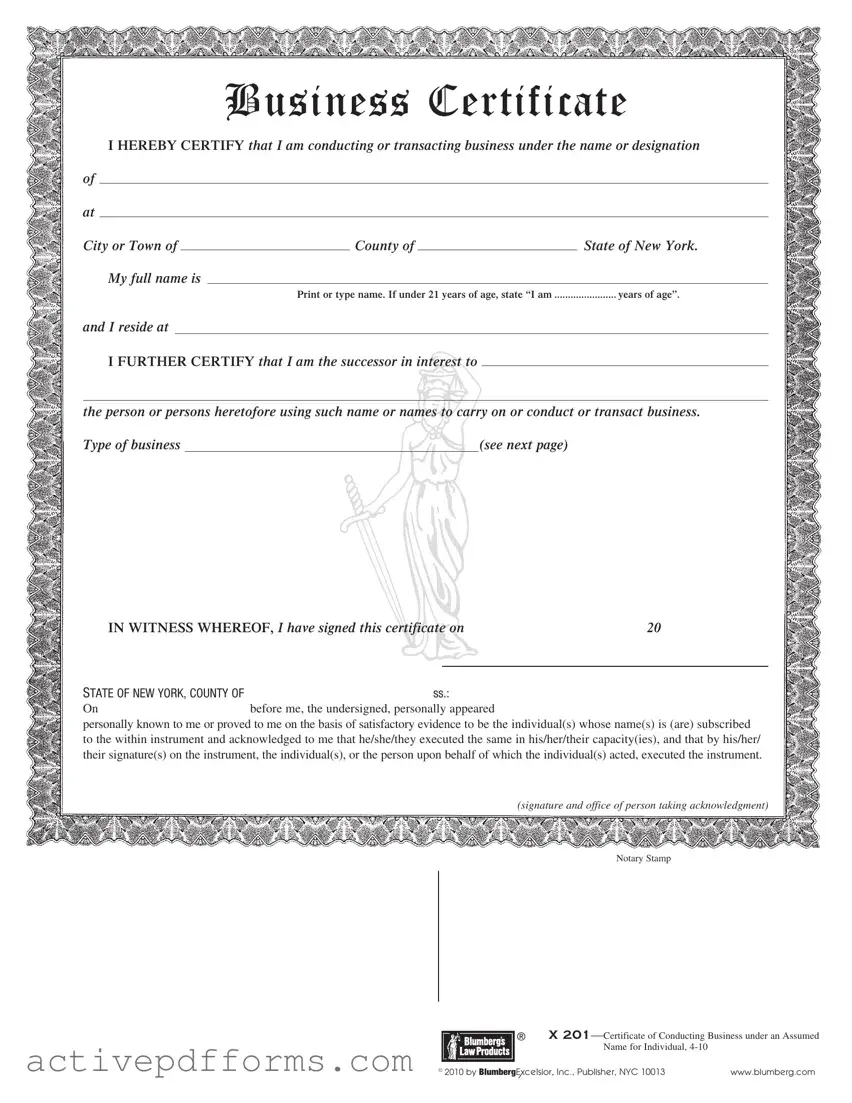BUSINESS CERTIFICATE
I HEREBY CERTIFY that I am conducting or transacting business under the name or designation
of at
City or Town ofCounty ofState of New York. My full name is
Print or type name. If under 21 years of age, state “I am |
years of age”. |
and I reside at
I FURTHER CERTIFY that I am the successor in interest to
the person or persons heretofore using such name or names to carry on or conduct or transact business.
Type of business |
|
(see next page) |
IN WITNESS WHEREOF, I have signed this certificate on |
20 |
STATE OF NEW YORK, COUNTY OF |
|
|
|
SS.: |
|
On |
before me, the undersigned, personally appeared |
|
personally known to me or proved to me on the basis of satisfactory evidence to be the individual(s) whose name(s) is (are) subscribed to the within instrument and acknowledged to me that he/she/they executed the same in his/her/their capacity(ies), and that by his/her/ their signature(s) on the instrument, the individual(s), or the person upon behalf of which the individual(s) acted, executed the instrument.
(signature and office of person taking acknowledgment)
Notary Stamp
|
|
® |
X 201—Certificate of Conducting Business under an Assumed |
|
|
|
Name for Individual, 4-10 |
|
|
|
|
|
© 2010 by BlumbergExcelsior, Inc., Publisher, NYC 10013 |
www.blumberg.com |

State of New York |
|
ss.: |
State of |
ss.: |
County of |
|
|
|
County of |
|
|
|
|
|
|
|
On |
|
|
before me, the undersigned, |
On |
before me, the undersigned, |
personally appeared |
|
|
|
personally appeared |
|
|
personally known to me or proved to me on the basis of satisfac- |
personally known to me or proved to me on the basis of satis- |
tory evidence to be the individual(s) whose name(s) is (are) sub- |
factory evidence to be the individual(s) whose name(s) is (are) |
|
PREVIEW |
scribed to the within instrument and acknowledged to me that he/ |
subscribed to the within instrument and acknowledged to me |
she/they executed the same in his/her/their capacity(ies), and that |
that he/she/they executed the same in his/her/their capacity(ies), |
by his/her/their signature(s) on the instrument, the individual(s), or |
and that by his/her/their signature(s) on the instrument, the |
the person upon behalf of which the individual(s) acted, executed |
individual(s), or the person upon behalf of which the individual(s) |
the instrument. |
|
|
|
|
|
acted, executed the instrument. |
|
|
|
(signature and office of individual taking acknowledgment) |
(signature and office of individual taking acknowledgment) |
|
|
|
|
INDEX No. |
|
|
|
|
|
|
|
|
|
|
|
|
|
|
|
|
|
|
CERTIFICATE |
|
|
|
|
|
|
|
|
OF |
|
|
|
PREVIEW |
|
|
|
|
CONDUCTING BUSINESS UNDER |
|
|
THE NAME OF
GBL §130.4. A certified copy of the original certificate, or if an amended certificate has been filed, then of the most recent amended certificate filed shall be conspicuously displayed on the premises at each place in which the business for which the same was filed is conducted.
Some counties request the type of business.
Consultant Services |
Medical—Home Care Services |
Educational Services |
Professional—Technical Services |
Entertainment–Recreation |
Real Estate Services |
Finance–Insurance Services |
Retail Trade |
Home Improvement Services |
Wholesale Trade |
Other (state type) |
|


